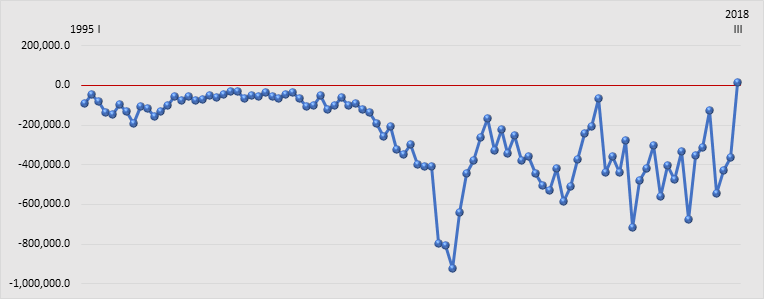Resume: A country’s balance of payments includes comprehensive data about money inflows and outflows. It also illustrates the movement of money between the economy of a specific country and the rest of the world. Current account is one of the constituent parts of balance of payments and includes trade with goods and services, as well as components of revenues and remittances. Positive balance in current account means that in a given period of time, money inflows exceed money outflows, which is a positive thing.
In the third quarter of 2018, Georgia’s current account ran in surplus, which happened for the first time in the history of independent Georgia. In 2010-2017, current account deficit to GDP ratio amounted nearly 10.8%, whilst the in the third quarter of 2018, current account surplus, which was nearly USD 12 million, was positive and constituted 0.3% of Georgia’s GDP. These numbers are in line with the figures named by the President of the National Bank.
Analysis
On 31 December 2018, the President of the National Bank, Koba Gvenetadze, posted the following on his own Facebook account: “For the first time in the history of independent Georgia, in the third quarter of 2018, current account balance runs with small, but surplus, which reached 0.3% of Georgia’s GDP. Historically, current account balance has always been negative in Georgia. Since 2010, current account deficit has been 11% of the GDP on average.”
A country’s balance of payments includes comprehensive data about money inflows and outflows. It also illustrates the movement of money between the economy of a specific country and the rest of the world. A country’s balance of payments consists of its current account, capital account and financial account.
A current account includes the component of trading with goods and services as well as incomes and transfers. The income component shows inflows of income from abroad (specifically, labour remuneration and investment income) and incomes transferred from abroad. Transfers include current transfers between the residents and non-residents of a country (for instance grants, financial assistance).
A capital account consists of purchase/assignations of capital transfers and non-produced non-financial assets. One of the forms of capital transfers is the forgiveness of debt.
A financial account includes direct investments, portfolio investments, financial derivatives, other investments and reserve assets. If a country’s current account is deficit; that is, if more money leaves the country as compared to what comes in, the gap is covered by the financial account (by investments, taking debt and a decrease in monetary reserves).
In the third quarter of 2018, current account ran in surplus, which means that at the expense of the current account components, money inflows did exceed money outflows. Balance of payments statistics are published by the National Bank of Georgia.
Table 1: Georgia’s Current Account Dynamics in 2010-2018
|
|
2010 |
2011 |
2012 |
2013 |
2014 |
2015 |
2016 |
2017 |
2017 III Quarter |
2018 III Quarter |
|
GDP (GEL Million) |
20,743 |
24,344 |
26,167 |
26,847 |
29,150 |
31,756 |
34,028 |
37,847 |
9,872 |
10,587 |
|
GDP (USD Million) |
11,637 |
14,438 |
15,848 |
16,140 |
16,508 |
13,988 |
14,378 |
15,088 |
4,078 |
4,185 |
|
Current Account (USD Million) |
-1,195 |
-1,843 |
-1,886 |
-958 |
-1,789 |
-1,763 |
-1,889 |
-1,333 |
-124.9 |
11.9 |
|
Current Accunt to GDP Ratio (%) |
-10.3 |
-12.8 |
-11.9 |
-5.9 |
-10.8 |
-12.6 |
-13.1 |
-8.8 |
-3.1 |
0.3 |
Source: National Bank of Georgia
Current account deficit in 2017 was USD 1.337 billion, and in the third quarter of the same year, the deficit was USD 124.9 million (3% of Georgia’s GDP). In accordance with the 2018 third quarter data, current account surplus amounts nearly USD 12 million, which constitutes 0.3% of GDP of the same period. In 2010-2017 that figure was -10.8% on average.
Graph 1: Current Account in 2000-2018 (USD Million)

Source: National Bank of Georgia
As illustrated by the graph 1, in 2000-2018 current account was running in deficit and the third quarter of 2018 is the only exception, when current account is in surplus. In regard to changes at the components’ level, they are given in the table 2.
Table 2: Current Account in the Third Quarters of 2017 and 2018 (USD Thousand)
|
IIIQ 2017 |
IIQ 2018 |
IIIQ 2018 |
|
|
Current Account |
-124,907 |
-364,032 |
11,906 |
|
Goods |
-978,671 |
-1,030,099 |
-1,004,547 |
|
Revenues |
924,092 |
1,146,980 |
1,133,714 |
|
Expenses |
-1,902,763 |
-2,177,079 |
-2,138,261 |
|
Services |
848,030 |
574,214 |
950,103 |
|
Revenues |
1,425,009 |
1,119,533 |
1,560,171 |
|
Expenses |
-576,978 |
-545,319 |
-610,068 |
|
Incomes |
-274,279 |
-259,392 |
-242,945 |
|
Revenues |
319,078 |
322,539 |
315,097 |
|
Expenses |
-593,356 |
-581,931 |
-558,042 |
|
Current Transfers |
280,013 |
351,245 |
309,294 |
|
Revenues |
313,562 |
383,197 |
345,491 |
|
Expenses |
-33,550 |
-31,952 |
-36,197 |
Source: National Bank of Georgia
In the third quarter of 2018, as compared to the same period of the previous year, trade with goods component decreased by USD 25 million, service (tourism, transport) component increased by USD 102 million, income component increased by USD 31 million and current transfers increased by USD 29 million. As compared to the second quarter of 2018, in the third quarter of the same year trade component increased by USD 25 million, component of services increased by USD 375 million, income component increased by USD 16 million and current transfers decreased by USD 42 million.








